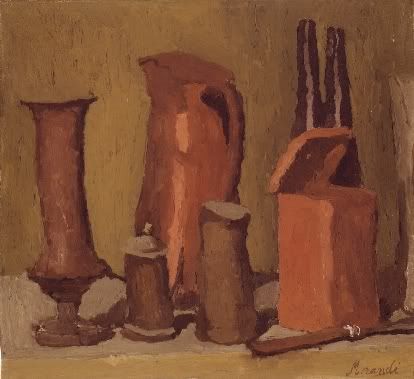
Giorgio Morandi, Still life, 1939, oil on canvas
Colecção do Museu de Arte Contemporânea da Universidade de São Paulo

Giorgio Morandi, Still life, 1930, oil on canvas

Giorgio Morandi, Still Life, 1958, pencil on paper
A exposição Giorgio Morandi 1890-1964 no Metropolitan Museum of Art, em New York, encerrou a 14 de Dezembro. A seguir, estará patente no MAMbo, Museo d'Arte Moderna di Bologna, de 22 de Janeiro a 13 de Abril de 2009.
«On the occasion of the show (which makes its only other stop in Bologna next year), we talked to four artists who count Morandi as a model and inspiration.
Robert Irwin
"We put on a Morandi show at Ferus. We were trying to explain to some people what a so-called abstract painting was about, and what Abstract Expressionism was all about. The best example in the world was Giorgio Morandi. Morandi, in my opinion, was the only genuine European Abstract Expressionist.
When you look at the work, you think he's painting bottles, little still-life paintings, but they weren't. Morandi came in the back door. It was almost a Zen activity. He painted the same bottles over and over and over, so it wasn't really about bottles anymore. If he was a still-life painter, he wouldn't have painted the same bottles over and over.
They're about painting - the figure-ground relationship, structure and organization. Morandi's were paintings in the purest sense of the word. They were like a mantra, repeated over and over until it was divorced from words and became pure sounds."
Vija Celmins
"I tried not to mimic him, but I did a series of paintings of objects then. He helped me drop the color I was into and helped me explore light. I think he was an influence in a broader way, saying let's just go back to looking and letting your hand make decisions. That's basically what I did. I went back to painting without trying to project so much, to express so many opinions, my ideas about what great painting was.
[Morandi's is] not really humble work, either. It's really ambitious work. It's about painting a world. The thing that amazed me most in his studio was how big the bottles were, and they were painted. He painted the bottles in various shades of gray, which catches all the light. The paintings were about a world that came from his interior, and he painted the reality to go with what he was already looking for and feeling and wanting to see.
Later, when I learned to look at painting in a more complex way, I began to see how strange and controlled the still lifes were, how strange the space was, how alive the paint was. There was this exquisite balance between the extreme stillness and the movement in his paintings. My work is quite restrained. Maybe I recognized that holding back in Morandi's work and it helped me. It gave me the courage to try, to go in that direction instead of trying to be someone else, someone more exciting maybe."
Dan McCleary
"The first time I saw the paintings and the etchings, I couldn't believe them -- the stillness, the ability to create light with such a limited palette. The paintings looked very awkward and clumsy, like they were about to fall apart. They don't look bravura, but have a radiance and beauty.
More than the paintings, the etchings have had a very direct influence on me. I have a book of Morandi etchings that's like my Bible. Wherever I go to do my printing, I bring the book with me. He believed that the line of the etching gave off light, because it's not like pen and ink, it's raised on the paper. It refracts light. (...)"
Uta Barth
"The history of Western art teaches us to interpret images, to search out and decipher symbolism, to find the narrative of what is being told. Morandi gives us none of that. He gives us silence, observation and a deep love of vision itself, vision divorced from interpretation. He invites us to see, rather than read.
This is not an easy task; I know all too well, since it is what I strive for in each body of work I have made throughout the years. I want my viewer to engage and submerge themselves in the act of looking and not in thoughts about what they are looking at. Repetition, redundancy are a path to this end. Look at one chipped and clumsy group of bottles and odd vases and one may think about what they mean; look at countless repetition of the same objects and it becomes clear that something else must be at play.
Morandi's objects are clumsy and plain, yet the paintings are some of the most beautiful I have ever seen. They are a love affair with painting, with observation and vision; humble and silent, they invite us to see. They are silent paintings stripped down to form, composition, light and color."»
in Giorgio Morandi, bottle by bottle, Los Angeles Times, Arts & Culture
A ver -
- Museo Morandi
- Giorgio Morandi e a natureza-morta na Itália, de Maria Cristina Bandera e Renato Miracco, Instituto de Estudos Avançados da Universidade de São Paulo
- Giorgio Morandi: 1890-1964, Los Angeles Times, Arts & Culture
- Giorgio Morandi, bottle by bottle, Los Angeles Times, Arts & Culture
- Astronomía de Morandi, de Antonio Muñoz Molina, El País, Cultura
___
























2 comentários:
Obrigada pela partilha da informação
Feliz 2009
Não tem de quê :o)
Um feliz Ano Novo, Fátima.
Enviar um comentário